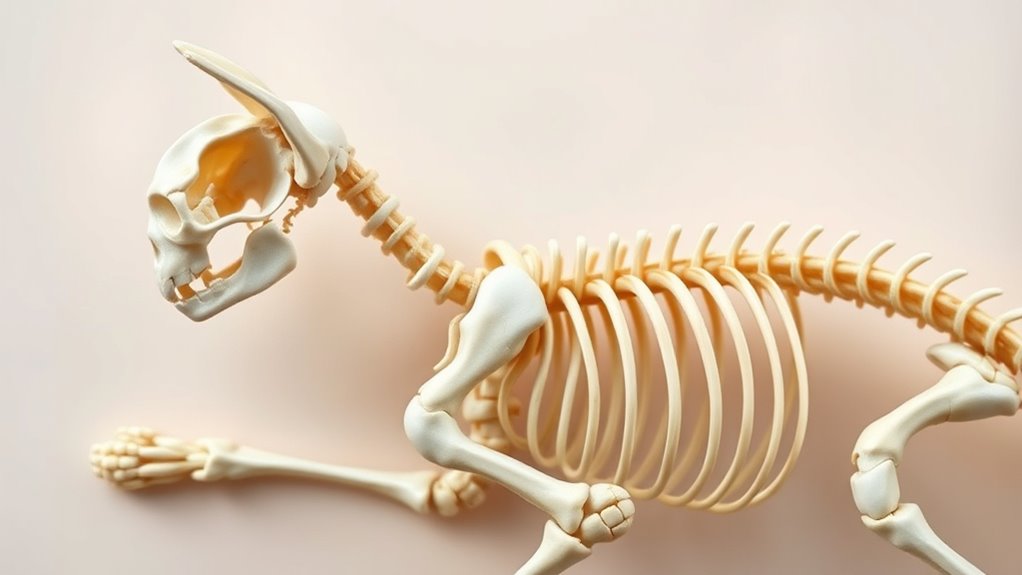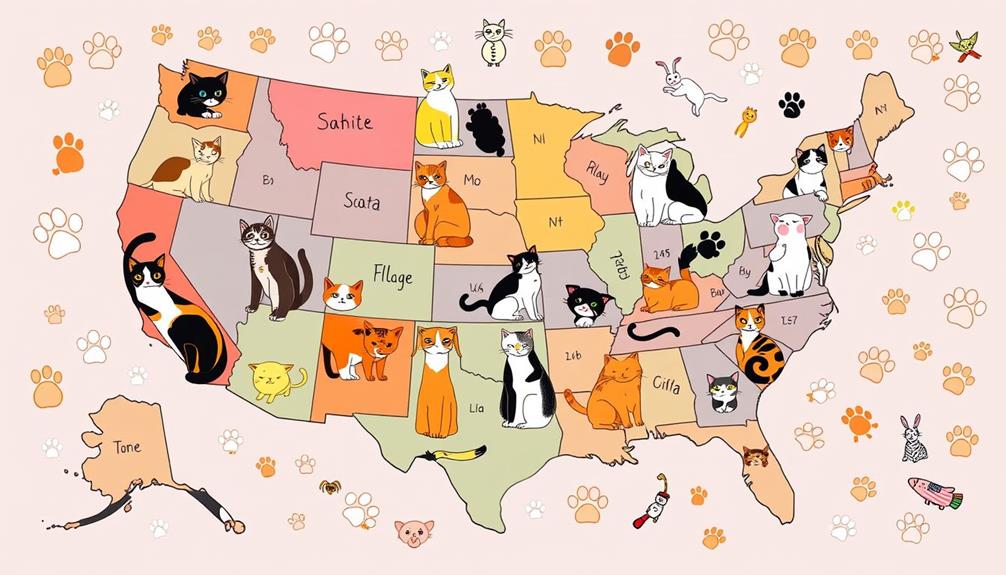Cats usually have between 230 and 250 bones in their bodies. This number can change slightly due to individual factors like breed and having extra toes. Each bone plays a crucial role in their agility and balance, allowing them to twist and move gracefully. Their unique skeletal features, like a free-floating collarbone, help navigate tight spaces. If you’re curious about how bones contribute to a cat’s movement and health, there’s more to explore.
Key Takeaways
- Cats typically have between 230 to 250 bones in their bodies.
- The exact bone count can vary slightly among individual cats.
- Polydactyl cats may have extra toes, influencing their overall bone count.
- Bone count differences can also be breed-specific.
- Despite variations, bone count does not significantly affect skeletal function.

Although you might see a playful cat leaping gracefully across the room, there’s a complex skeletal structure at work that supports those agile movements. You may not realize it, but your cat’s body is made up of approximately 230 to 250 bones. This number can vary slightly due to the presence of extra toes or polydactylism in some breeds. Each bone plays a crucial role in maintaining the cat’s overall balance and flexibility, which is essential for their natural hunting and climbing instincts.
A cat’s agility stems from its intricate skeleton, composed of 230 to 250 bones, essential for balance and flexibility.
The cat skeletal structure is unique, designed for agility and stealth. Unlike humans, cats have a more flexible spine, allowing them to twist and turn mid-air while falling. This flexibility, combined with their lightweight bones, enables them to execute those impressive jumps and twists you often admire. Their collarbone, or clavicle, is also free-floating, which gives them the ability to squeeze through tight spaces and navigate their environment with ease.
Feline bone health is essential for your cat’s overall well-being, especially as they age. Just like humans, cats can suffer from bone-related issues such as arthritis or osteoporosis. Ensuring your cat gets the right nutrition, including calcium and phosphorus, is vital for keeping their bones strong and healthy. You should also provide opportunities for exercise and play, which help maintain their bone density and strength. Regular vet check-ups can catch potential issues early and keep you informed about your cat’s skeletal health. Additionally, being aware of bone-related issues can help you take proactive steps to care for your feline friend.
It’s fascinating to think about how each of those bones contributes to your cat’s agility and grace. The skull protects their brain, while the vertebrae support their spine, allowing for that incredible flexibility. Each leg bone is designed for strength and support, giving your cat the ability to run swiftly or leap high. Even their tiny toes hold a significant purpose, providing balance and traction as they navigate various surfaces.
Frequently Asked Questions
Do Kittens Have More Bones Than Adult Cats?
No, kittens don’t have more bones than adult cats. In fact, kittens start with around 270 bones, but as they grow, some of these bones fuse together, resulting in the typical 230 bones found in adult cats. This process is part of normal kitten bone development. So, while you might notice some cat skeletal variations, it’s all part of their growth and maturation into adult felines.
How Does a Cat’s Bone Structure Differ From Dogs?
When it comes to cats and dogs, you’ve heard the saying, “Different strokes for different folks.” Cats have a more flexible spine and lighter bone structure, showcasing their skeletal diversity, which allows for agile movements. In contrast, dogs typically possess a denser bone structure, providing strength. This comparative bone density helps dogs excel in endurance and weight-bearing activities, while cats shine in their ability to leap and twist with grace.
Can Cats Break Their Bones Easily?
Yes, cats can break their bones, but it largely depends on their bone density and the situation. Generally, cats have high bone density, which lowers their fracture risk compared to some other animals. However, if they engage in risky activities, like jumping from heights or getting into fights, they could still suffer fractures. Keeping your cat safe and monitoring their activity can help prevent potential injuries and keep their bones healthy.
What Is the Lifespan of a Cat’s Bones?
A cat’s bones can last a lifetime, much like a sturdy bridge weathering storms. Typically, feline skeletal health peaks in young adulthood, with their bone density gradually declining as they age. You’ll notice this in your cat’s playfulness; if they’re less spry, it might signal weakening bones. Regular vet check-ups and a balanced diet can help maintain their bone strength, ensuring those agile leaps remain part of their charm for years to come.
How Do Cat Bones Heal After an Injury?
When your cat injures a bone, the healing process begins with inflammation, followed by bone regeneration. Blood clots form, and specialized cells start repairing the damaged area. Over time, new bone tissue develops, gradually restoring strength. You’ll notice your cat may limit activity during recovery to avoid further injury. It’s essential to monitor their progress and consult your vet to guarantee the healing process is on track and the bone heals correctly.
Conclusion
In summary, while you might think cats have fewer bones than humans, they actually have about 230 to 250 bones, depending on the length of their tails. Some may argue that this number is insignificant compared to our 206 bones, but remember, a cat’s unique skeletal structure allows for incredible flexibility and agility. Their bones are designed for stealth and precision, which is why they’re such amazing hunters. So, those extra bones really make a difference!









